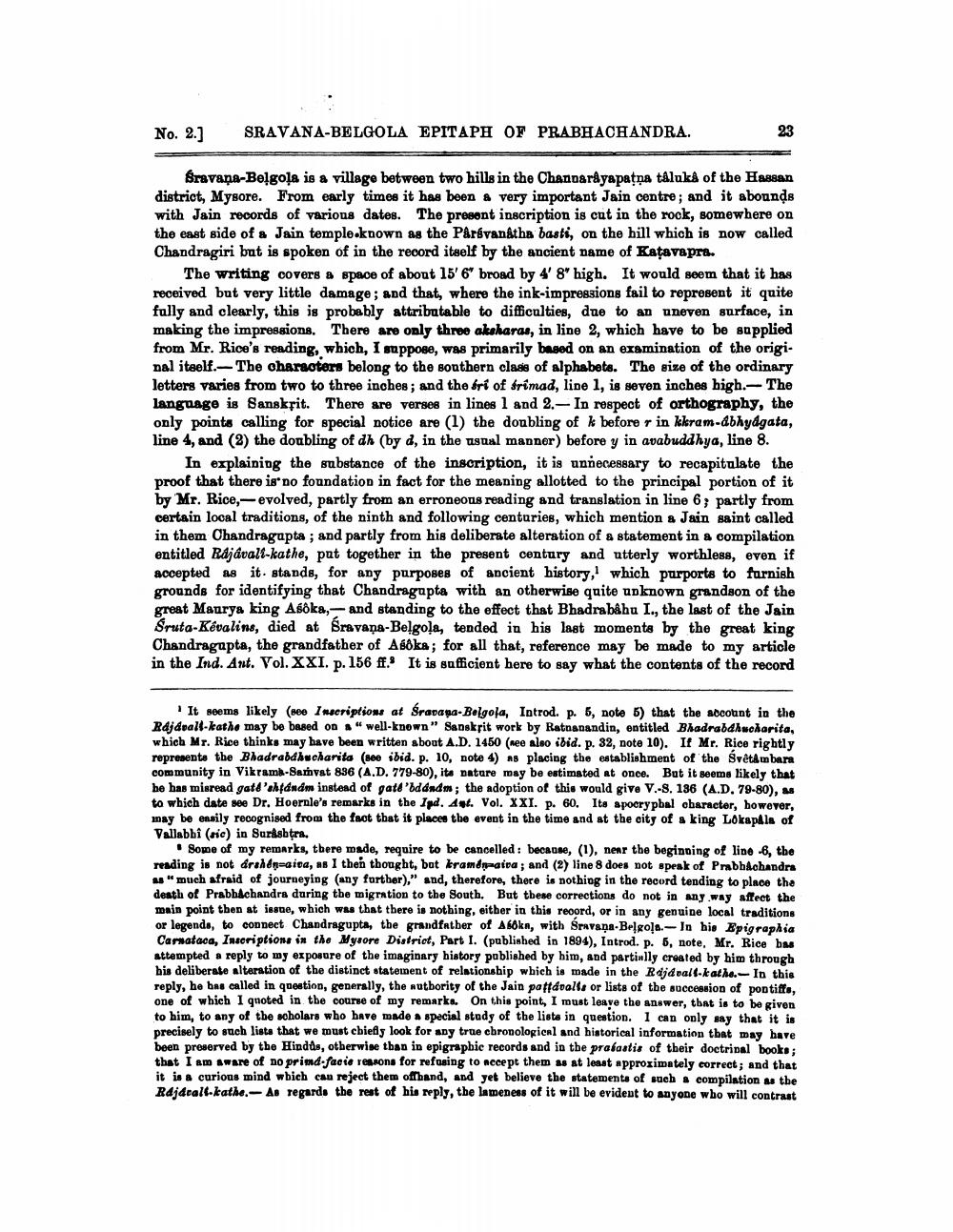________________
No. 2.]
SRAVANA-BELGOLA EPITAPH OF PRABHACHANDRA.
23
Sravana-Belgola is a village between two hills in the Channarayapatna taluk of the Hassan district, Mysore. From early times it has been a very important Jain centre; and it abounds with Jain records of various dates. The present inscription is cut in the rock, somewhere on the east side of a Jain temple.known as the Pârévan&tha basti, on the hill which is now called Chandragiri but is spoken of in the record itself by the ancient name of Katavapra.
The writing covers a space of about 15' 6" broad by 4' 8" high. It would seem that it has received but very little damage; and that, where the ink-impressions fail to represent it quite fully and clearly, this is probably attributable to difficulties, due to an uneven surface, in making the impressions. There are only three aksharas, in line 2, which have to be supplied from Mr. Rice's reading, which, I suppose, was primarily based on an examination of the original itself. The characters belong to the southern class of alphabets. The size of the ordinary letters varies from two to three inches; and the fri of śrimad, line 1, is seven inches high.- The language is Sanskrit. There are verses in lines 1 and 2.- In respect of orthography, the only points calling for special notice are (1) the doubling of k before r in kkram-ábhyagata, line 4, and (2) the doubling of dh (by d, in the usual manner) before y in avabuddhya, line 8.
In explaining the substance of the inscription, it is unnecessary to recapitulate the proof that there is no foundation in fact for the meaning allotted to the principal portion of it by Mr. Rice,-evolved, partly from an erroneous reading and translation in line 6; partly from certain local traditions, of the ninth and following centuries, which mention a Jain saint called in them Chandragupta; and partly from his deliberate alteration of a statement in a compilation entitled Rájávali-kathe, put together in the present century and utterly worthless, even if accepted as it stands, for any purposes of ancient history, which purports to furnish grounds for identifying that Chandragupta with an otherwise quite unknown grandson of the great Maurya king Asôka, and standing to the effect that Bhadrabahu I., the last of the Jain Sruta-Kévalins, died at Sravana-Belgola, tended in his last moments by the great king Chandragupta, the grandfather of Asoka; for all that, reference may be made to my article in the Ind. Ant. Vol. XXI. p. 156 ff. It is sufficient here to say what the contents of the record
It seems likely (see Inscriptions at Sravana-Belgola, Introd. p. 5, note 5) that the account in the Rájávali-kathe may be based on a "well-known" Sanskrit work by Ratnanandin, entitled Bhadrabdhucharita, which Mr. Rice thinks may have been written about A.D. 1450 (see also ibid. p. 32, note 10). If Mr. Rice rightly represents the Bhadrabdhucharita (see ibid. p. 10, note 4) as placing the establishment of the Svêtambara community in Vikrams-Samvat 836 (A.D. 779-80), its nature may be estimated at once. But it seems likely that he has misread gate'shtdnám instead of gate 'bdándm; the adoption of this would give V.-S. 136 (A.D. 79-80), as to which date see Dr. Hoernle's remarks in the Ipd. Ast. Vol. XXI. p. 60. Its apocryphal character, however, may be easily recognised from the fact that it places the event in the time and at the city of a king Lokapala of Vallabhi (sic) in Surashtra.
Some of my remarks, there made, require to be cancelled: because, (1), near the beginning of line -6, the reading is not drahén-aiva, as I then thought, but kramen-aira; and (2) line 8 does not speak of Prabhachandra as "much afraid of journeying (any further)," and, therefore, there is nothing in the record tending to place the death of Prabhachandra during the migration to the South. But these corrections do not in any way affect the main point then at issue, which was that there is nothing, either in this record, or in any genuine local traditions or legends, to connect Chandragupta, the grandfather of A66kn, with Sravana-Belgola.- In his Epigraphia Carnataca, Inscriptions in the Mysore District, Part I. (published in 1894), Introd. p. 5, note, Mr. Rice bas attempted a reply to my exposure of the imaginary history published by him, and partially created by him through his deliberate alteration of the distinct statement of relationship which is made in the Rajd vali-kathe.- In this reply, he has called in question, generally, the authority of the Jain paffdvalls or lists of the succession of pontiffs, one of which I quoted in the course of my remarks. On this point, I must leave the answer, that is to be given to him, to any of the scholars who have made a special study of the lists in question. I can only say that it is precisely to such lists that we must chiefly look for any true chronological and historical information that may have been preserved by the Hindus, otherwise than in epigraphic records and in the prasastis of their doctrinal books; that I am aware of no primd-facie reasons for refusing to accept them as at least approximately correct; and that it is a curious mind which cau reject them offhand, and yet believe the statements of such a compilation as the Rájávalt-kathe. As regards the rest of his reply, the lameness of it will be evident to anyone who will contrast




